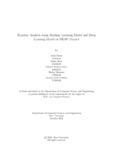| dc.contributor.advisor | Mostakim, Moin | |
| dc.contributor.advisor | Parvez, Mohammad Zavid | |
| dc.contributor.author | Hasan, Anita | |
| dc.contributor.author | Abrar, Fahim | |
| dc.contributor.author | Sabur, Eshaan Tanzim | |
| dc.contributor.author | Muntasir, Iftehaj | |
| dc.contributor.author | Na sha, Sumaia Sadia | |
| dc.date.accessioned | 2022-06-01T06:34:50Z | |
| dc.date.available | 2022-06-01T06:34:50Z | |
| dc.date.copyright | 2021 | |
| dc.date.issued | 2021-10 | |
| dc.identifier.other | ID 17301221 | |
| dc.identifier.other | ID 21341028 | |
| dc.identifier.other | ID 16101255 | |
| dc.identifier.other | ID 17301223 | |
| dc.identifier.other | ID 17201030 | |
| dc.identifier.uri | http://hdl.handle.net/10361/16788 | |
| dc.description | This thesis is submitted in partial fulfillment of the requirements for the degree of Bachelor of Science in Computer Science and Engineering, 2021. | en_US |
| dc.description | Cataloged from PDF version of thesis. | |
| dc.description | Includes bibliographical references (pages 46-50). | |
| dc.description.abstract | Emotion has a signi cant in
uence on how you think and interact with others. It
serves as a link between how you feel and the actions you take, or you could say it
in
uences your life decisions on occasion. Since the patterns of emotions and their
re
ections vary from person to person, their inquiry must be based on approaches
that are e ective over a wide range of population regions. To extract features and
enhance accuracy, emotion recognition using brain waves or EEG signals requires
the implementation of e cient signal processing techniques. Various approaches
to human-machine interaction technologies have been ongoing for a long time, and
in recent years, researchers have had great success in automatically understanding
emotion using brain signals. In our research, several emotional states were classi ed
and tested on EEG signals collected from a well-known publicly available dataset, the
DEAP Dataset, using SVM (Support Vector Machine), KNN (K-Nearest Neighbor),
and an advanced Neural Network model RNN (Recurrent Neural Network) trained
with LSTM (Long Short Term Memory). The main purpose of this study is to
use improved ways to improve emotion recognition performance using brain signals.
Emotions, on the other hand, can change with time. As a result, the changes in
emotion through time are also examined in our research. | en_US |
| dc.description.statementofresponsibility | Anita Hasan | |
| dc.description.statementofresponsibility | Fahim Abrar | |
| dc.description.statementofresponsibility | Eshaan Tanzim Sabur | |
| dc.description.statementofresponsibility | Iftehaj Muntasir | |
| dc.description.statementofresponsibility | Sumaia Sadia Na sha | |
| dc.format.extent | 50 pages | |
| dc.language.iso | en | en_US |
| dc.publisher | Brac University | en_US |
| dc.rights | Brac University theses are protected by copyright. They may be viewed from this source for any purpose, but reproduction or distribution in any format is prohibited without written permission. | |
| dc.subject | Deap dataset | en_US |
| dc.subject | EEG | en_US |
| dc.subject | Prediction | en_US |
| dc.subject | Emotionomics | en_US |
| dc.subject.lcsh | Machine learning | |
| dc.title | Emotion analysis using machine learning model and deep learning model on DEAP dataset | en_US |
| dc.type | Thesis | en_US |
| dc.contributor.department | Department of Computer Science and Engineering, Brac University | |
| dc.description.degree | B. Computer Science | |

